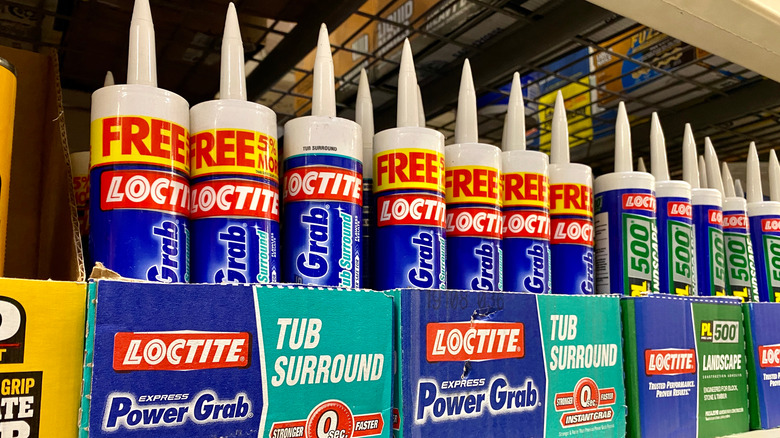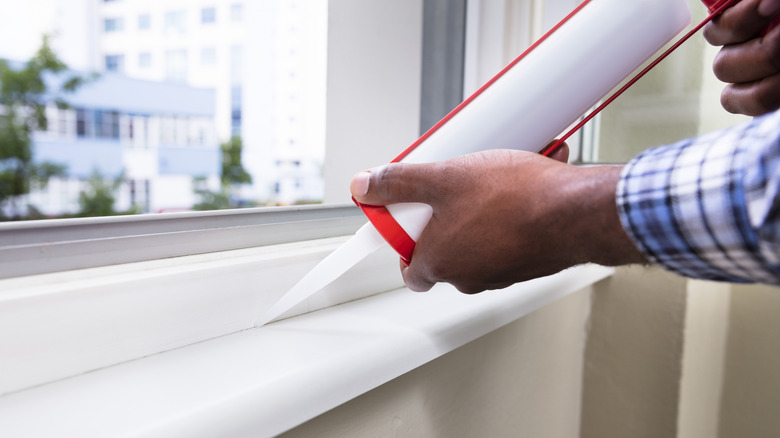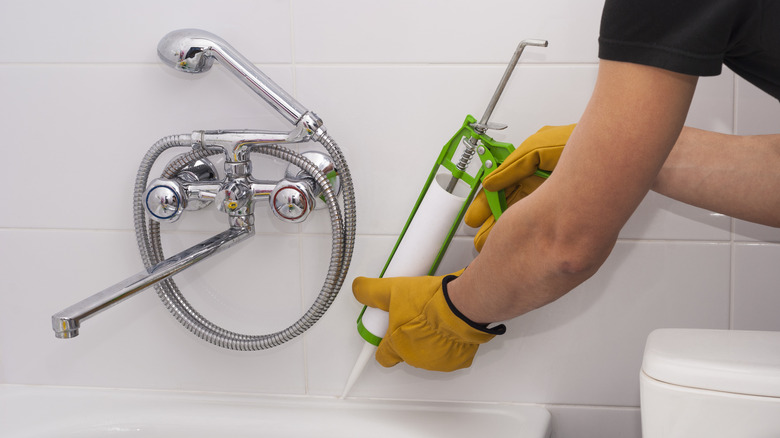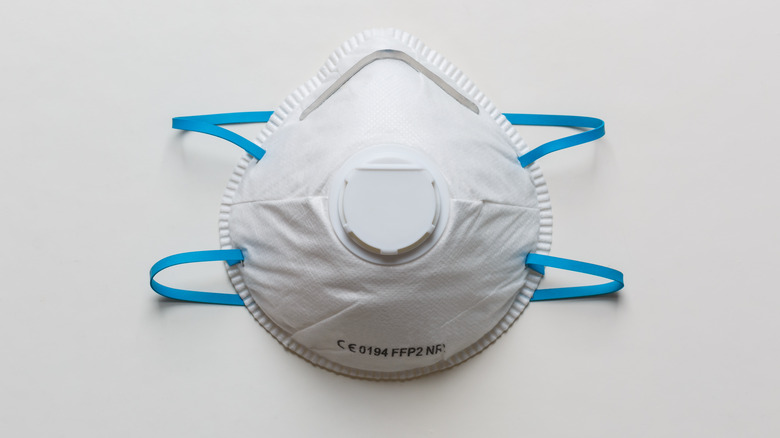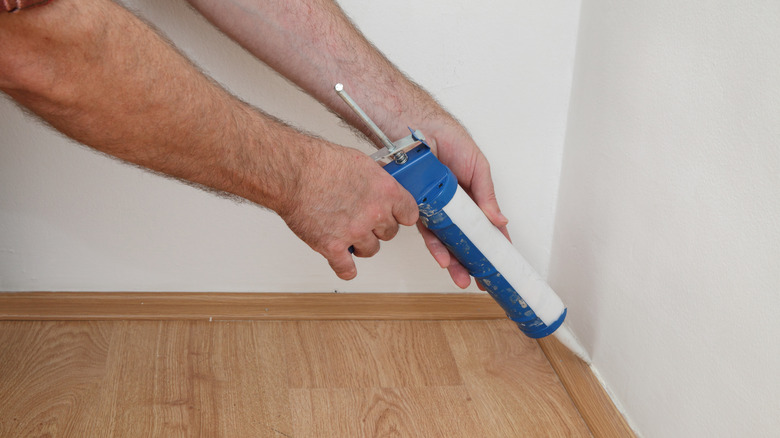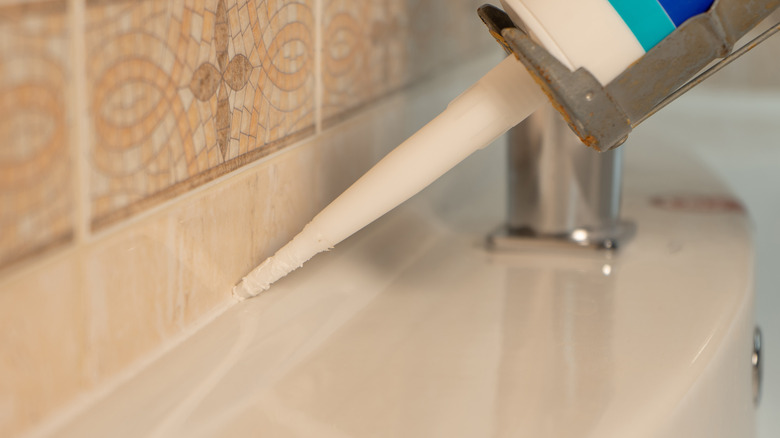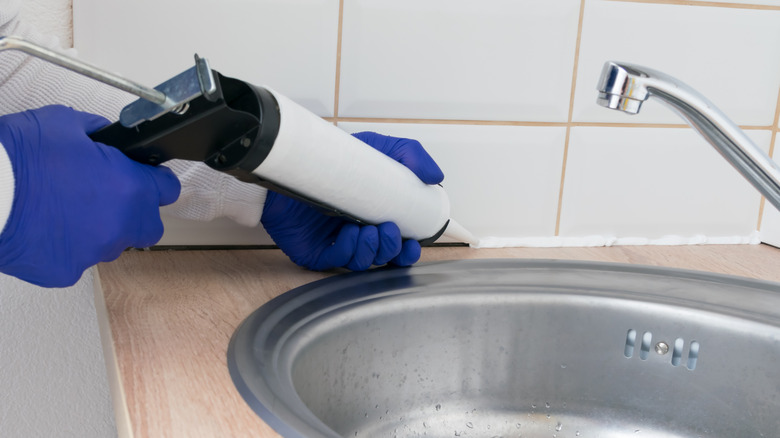Caulk Vs Silicone: Which One Should You Use
When finishing a project in your home, odds are that you will need a sealant to add the finishing touches and keep the installation both fresh and functional. A trip to the hardware store sealant aisle, though, may prove overwhelming, with rows and rows of items all marketed as the best for the job. In reality, the sealant that's best for you is entirely dependent on the project at hand.
When it comes to sealants, the two most popular and commonly used are caulk and silicone. Both are typically sold in cylindrical tubes with an accompanying caulking or sealing gun for easy disbursement. Further, most caulks are a blend of latex and acrylic, while silicone is made out of 100% silicone, according to Oatey. While they may sometimes be marketed interchangeably, they are made of entirely different chemicals and have entirely different purposes. To know which one is right for your home upgrade project, keep reading.
How does the composition differ?
The first big difference between caulk and silicone sealants is their composition. As stated earlier, silicone sealants are just that — 100% pure silicone, which is a rubber and plastic polymer hybrid made of silicon and oxygen that forms a resin-like material, explains Life Without Plastic. Silicone is sometimes added to certain types of caulk, too.
Caulk, on the other hand, can refer to a variety of products with different chemical makeups. One of the most common types of caulk is latex, or acrylic latex caulk, which, as the name would suggest, is a combination of acrylic and latex, according to Home Depot. Another type of caulk is foam caulk, which is made from an expandable plastic called polyurethane and is used to fill gaps and cracks in the home. Lastly, butyl-rubber caulk is a highly durable synthetic rubber material used for outdoor caulking projects.
What are the differences in cost?
The difference in cost between caulk and silicone sealant isn't astronomical, but for large projects, it can start to add up. Generally, since silicone is a pure material, sold as 100% silicone, it is more expensive than other sealant products, points out The Spruce. Silicone varieties can also be faster drying or sold in different colors, making this material a bit more convenient and potentially worth the higher price tag.
On the other hand, caulk tends to run on the cheaper side, as it's a hybrid of different materials. While it can also be found in a variety of colors, caulk can be painted over, which lowers the initial price a bit.
The price varies depending on whether the product contains odor control and the amount of time it takes to dry as well. It also differs across brands. For example, this GE brand advanced silicone sealant from Home Depot is $8.78 for a 10-ounce tube. Contrastingly, this 10-ounce tube of acrylic latex caulk found at Home Depot is only $2.18.
What are the differences in odor?
When working with any chemically composed material, odors are not only going to be an irritant, but also a potential risk to your health. When caulking and sealing, whether with acrylic, latex, or rubber-based caulk or a silicone sealant, be sure to ventilate your home as much as possible and wear a dust mask.
That being said, neither caulk nor silicone is inherently dangerous. According to Poison Control, there are modern regulations on caulking products to eliminate polychlorinated biphenyls, or PCBs, which are believed to pose adverse health risks. However, the site points out that most caulk-related poisoning calls are due to children swallowing and choking on a hardened piece.
Most caulks don't have too strong of an odor. Silicone sealants, on the other hand, are somewhat notorious for their strong, unpleasant vinegar smell, which can last up to two days and cause feelings of dizziness, according to Hunker. There are silicone sealants marketed as odor-free, but be wary, as they likely won't be 100% silicone. While inhaling silicone fumes isn't necessarily bad, always do your best to facilitate air circulation in the room.
Pros and cons of caulk
When it comes to selecting a sealant for your home, it isn't so much a matter of which one is better or worse, but which one works best for your specific project. That being said, as with anything, there are definitely pros and cons to each product.
One major pro for caulk is, as discussed previously, the low price point. It can also commonly be purchased in bulk, saving you even more money. Another benefit of choosing caulk is that it can be painted over, according to Little House on the Corner. Caulk also tends to dry much faster than silicone. Lastly, once caulk has been applied, it won't budge.
One of the cons of caulk is that it can't be used in humid areas of the home with lots of expansion and contraction, as per Difference Between. It also has a tendency to shrink when it dries and sometimes requires a second coat. Finally, while acrylic caulk creates a watertight effect, it can lead to mildew and mold in high moisture areas, warns Today's Homeowner.
Pros and cons of silicone
Silicone sealants also have their share of pros and cons. According to Little House on the Corner, silicone is water-resistant. Not only does that make it ideal for application in high moisture areas like bathrooms, but sanitary silicones often have a fungicide that further prevents mold growth. Silicone also comes in a variety of colors for different projects. Finally, silicone is very elastic, and contractions and expansions won't damage, crack, or tear the sealant.
This type of sealant isn't without its drawbacks, though. Silicone, as covered previously, is a lot more expensive than caulk. It also can't be painted over, so the color you choose is what will be there permanently. Silicone sealants have a foul smell, and scent-free products are often a scam. Silicone also can't be layered. Lastly, Hunker warns that silicone sealants take a long time to dry and are quite difficult to remove.
Recommended use of each
While knowing the pros and cons of each product is beneficial before sealing or caulking, the product you need is entirely dependent on where you need it and what you need it for. According to Difference Between, caulk is both a sealant and filler, and helps stop water, moisture, air, and dust from passing through. Caulk is ideal for sealing cracks, gaps, and seams. It has a lot more heavy-duty applications, too, including sealing concrete, stucco, gutters, and siding. High-temperature resistant formulas can even be used for bricks in fireplaces, points out The Spruce.
Silicone sealant, on the other hand, is more flexible and waterproof, making it ideal for sealing sinks, bathtubs, showers, and other high moisture areas. The Spruce recommends silicone sealant for sinks, toilets, faucets, and tiles in rooms that tend to get wet. It can also be used as a waterproof sealant for exterior gaps and cracks, including piping and wiring.
